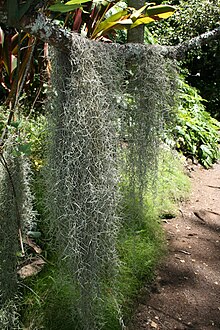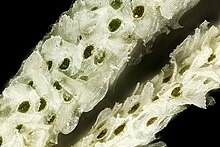Spanish moss
| Spanish moss | |
|---|---|

| |
| Scientific classification | |
| Kingdom: | Plantae |
| Clade: | Tracheophytes |
| Clade: | Angiosperms |
| Clade: | Monocots |
| Clade: | Commelinids |
| Order: | Poales |
| Family: | Bromeliaceae |
| Genus: | Tillandsia |
| Subgenus: | Tillandsia subg. Diaphoranthema |
| Species: | T. usneoides
|
| Binomial name | |
| Tillandsia usneoides | |
| Synonyms[2] | |
| |
Spanish moss (Tillandsia usneoides) is an epiphytic flowering plant that often grows upon large trees in tropical and subtropical climates. It is native to much of Mexico, Bermuda, the Bahamas, Central America, South America, the Southern United States, West Indies. It has been naturalized in Queensland (Australia). It is known as "grandpas beard" in French Polynesia.[2]
Most known in the United States, it commonly is found on the southern live oak (Quercus virginiana) and bald cypress (Taxodium distichum) in the lowlands, swamps, and marshes of the mid-Atlantic and southeastern states, from the coast of southeastern Virginia to Florida and west to southern Arkansas and Texas.[3][4]
The specific name of the plant, usneoides, means "resembling Usnea", a lichen.[5] While it superficially resembles its namesake, it is neither a lichen such as Usnea nor a moss, and it is not native to Spain.
It is a flowering plant (angiosperm) in the family Bromeliaceae (the bromeliads) that grows hanging from tree branches in full sun through partial shade. Formerly, it was placed in the genera Anoplophytum, Caraguata, and Renealmia.[6] The northern limit of its natural range is Northampton County,[7] Virginia, with colonial-era reports of it in southern Maryland[8][9][10][11] where no populations are now known to exist.[11] Its primary range is in the southeastern United States (including Puerto Rico and the U.S. Virgin Islands) through Argentina, where the climate is warm enough and a relatively high average humidity occurs.
It has been introduced to locations around the world with similar conditions, including Hawaii and Australia.
Description[]
Spanish moss consists of one or more slender stems, bearing alternate thin, curved or curly, and heavily scaled leaves 2–6 cm (0.8–2.4 inches) long and 1 mm (0.04 inches) broad, that grow vegetatively in a chain-like fashion (pendant), forming hanging structures of up to 6 m (20 feet).[12] The plant has no aerial roots,[12] and its brown, green, yellow, or grey flowers are tiny and inconspicuous. It propagates both by seed and vegetatively by fragments that blow on the wind and stick to tree limbs or that are carried to other locations by birds as nesting material.
Ecology[]

Spanish moss is not parasitic, it is an epiphyte that absorbs nutrients and water through its own leaves from the air and rainfall. While its presence rarely kills the trees on which it grows, it occasionally becomes so thick that, by shading the leaves of the tree, it lowers the growth rate of the tree.[12]
In the southern U.S., the plant seems to show preferences for southern live oak (Quercus virginiana) and bald cypress (Taxodium distichum) because of their high rates of foliar mineral leaching (calcium, magnesium, potassium, and phosphorus), which provides an abundant supply of nutrients to the epiphytic plant.[13] It can also colonize other tree species such as sweetgum (Liquidambar styraciflua), crepe-myrtles (Lagerstroemia spp.), other oaks, and even pines.
Spanish moss shelters a number of creatures, including rat snakes and three species of bats. One species of jumping spider, Pelegrina tillandsiae, has been found only on Spanish moss.[14] Although widely presumed to infest Spanish moss, chiggers were not present among thousands of other arthropods identified on the plant in one study of the ecology of the plant.[15]
Culture and folklore[]

Spanish moss often is associated with Southern Gothic imagery and Deep South culture, due to its propensity for growing in subtropical humid southern locales such as Alabama, Florida, Georgia, Louisiana, Mississippi, North Carolina, South Carolina, east and south Texas, and extreme southern Virginia.
One anecdote about the origin of Spanish moss is called "The Meanest Man Who Ever Lived", where the man's white hair grew very long and got caught on trees.[16]
Spanish moss was introduced to Hawaii in the nineteenth century. It became a popular ornamental and lei plant.[17] On Hawaii it often is called "Pele's hair" after Pele the Hawaiian goddess. ("Pele's hair" also refers to a type of filamentous volcanic glass.)
Human uses[]

Spanish moss has been used for various purposes, including building insulation, mulch, packing material, mattress stuffing, and fiber. In the early 1900s it was used commercially in the padding of car seats.[18] More than 10,000 tons of processed Spanish-moss was produced in 1939.[19] Today, it is collected in smaller quantities for use in arts and crafts, as bedding for flower gardens, and as an ingredient in the traditional wall covering material bousillage. In some parts of Latin America and Louisiana, it is used in Nativity scenes.
In the desert regions of southwestern United States, dried Spanish moss is sometimes used in the manufacture of evaporative coolers, colloquially known as "swamp coolers" (and in some areas as "desert coolers"), which are used to cool homes and offices much less expensively than air conditioners. The cooling technology uses a pump that squirts water onto a pad made of Spanish moss plants; a fan then pulls air through the pad, and into the building. Evaporation of the water on the pads serves to reduce air temperature, cooling the building.[20]
Cultivars[]
Hybrids[]
- Tillandsia 'Nezley' (Tillandsia usneoides × mallemontii)[26]
- Tillandsia 'Kimberly' (Tillandsia usneoides × recurvata)[27]
- (Tillandsia crocata × usneoides)[28]
References[]
- ^ "Tillandsia usneoides". Germplasm Resources Information Network (GRIN). Agricultural Research Service (ARS), United States Department of Agriculture (USDA). Retrieved 2009-12-08.
- ^ Jump up to: a b Kew World Checklist of Selected Plant Families, Tillandsia usneoides
- ^ Luther, Harry E.; Brown, Gregory K. (2000). "Tillandsia usneoides". In Flora of North America Editorial Committee (ed.). Flora of North America North of Mexico (FNA). 22. New York and Oxford – via eFloras.org, Missouri Botanical Garden, St. Louis, MO & Harvard University Herbaria, Cambridge, MA.
- ^ "Tillandsia usneoides". County-level distribution map from the North American Plant Atlas (NAPA). Biota of North America Program (BONAP). 2014.
- ^ Damrosch, B.; Neal, B. (2003). Gardener's Latin: A Lexicon. Chapel Hill, N.C: Algonquin Books. p. 129. ISBN 978-1-56512-743-2. OCLC 856021571. Retrieved 20 April 2019.
- ^ "Tillandsia". Germplasm Resources Information Network (GRIN). Agricultural Research Service (ARS), United States Department of Agriculture (USDA).
- ^ Times-Dispatch, REX SPRINGSTON Richmond. "Virginia scientists search for northernmost realm of Spanish moss". Richmond Times-Dispatch. Retrieved 2017-10-26.
- ^ John Ray 1688
- ^ "Plants profile for Tillandsia usneoides". USDA.
- ^ "Rare, Threatened, and Endangered Plants of Maryland" (PDF).
- ^ Jump up to: a b Brown, M.L., and R.G. Brown (1984). Herbaceous plants of Maryland. Baltimore: Port City Press, Inc.CS1 maint: uses authors parameter (link)
- ^ Jump up to: a b c "Tillandsia usneoides". Floridata Plant Encyclopedia.
- ^ Schlesinger, William H.; Marks, P. L. (1977). "Mineral Cycling and the Niche of Spanish Moss, Tillandsia usneoides L.". American Journal of Botany. 64 (10): 1254–1262. doi:10.2307/2442489. JSTOR 2442489.
- ^ Wildlife, State of Texas, Parks and. "Flora Fact:| Spanish Moss Serves as Nature's Draperies". www.tpwmagazine.com. Retrieved 2017-10-26.
- ^ Whitaker Jr., J; Ruckdeschel, C. (2010). "Spanish Moss, the Unfinished Chigger Story". Southeastern Naturalist. 9 (1): 85–94. doi:10.1656/058.009.0107. S2CID 86228838.
- ^ Friedman, Amy; Johnson, Meredith (May 28, 2017). "The Meanest Man Who Ever Lived (An American Folktale)". Uexpress. Retrieved May 31, 2017.
- ^ "Nā Lei o Hawai'i – Types of Lei". Archived from the original on 2013-01-03.
- ^ "Hair From Trees....Spanish-moss is new upholstering material". Popular Science. June 1937.
- ^ Adams, Dennis. Spanish Moss: Its Nature, History and Uses. Beaufort County Library, SC.
- ^ Gutenberg, Arthur William (1955). The Economics of the Evaporative Cooler Industry in the Southwestern United States. Stanford University Graduate School of Business. p. 167.
- ^ Bromeliad Cultivar Registry: Tillandsia 'Maurice's Robusta'
- ^ Bromeliad Cultivar Registry: Tillandsia 'Munro's Filiformis'
- ^ Bromeliad Cultivar Registry: Tillandsia 'Odin's Genuina'
- ^ Bromeliad Cultivar Registry: Tillandsia 'Spanish Gold'
- ^ Bromeliad Cultivar Registry: Tillandsia 'Tight and Curly'
- ^ Bromeliad Cultivar Registry: Tillandsia 'Nezley'
- ^ Bromeliad Cultivar Registry: Tillandsia 'Kimberly'
- ^ Bromeliad Cultivar Registry: Tillandsia 'Old Man's Gold'
- Mabberley, D.J. 1987. The Plant Book. A Portable Dictionary of the Higher Plants. Cambridge University Press, Cambridge. ISBN 0-521-34060-8.
External links[]
| Wikimedia Commons has media related to: Tillandsia usneoides (category) |
- Tillandsia
- Plants described in 1762
- Epiphytes
- Flora of the Caribbean
- Flora of Central America
- Flora of Mexico
- Flora of South America
- Flora of the Southeastern United States
- Flora of the South-Central United States
- Flora of the Bahamas
- Flora of Bermuda